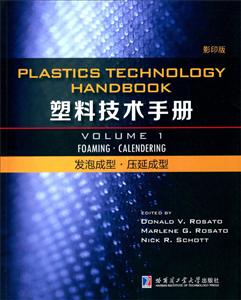塑料技术手册:Volume 1:发泡成型·压延成型:Foaming·calendering 版权信息
- ISBN:9787560350462
- 条形码:9787560350462 ; 978-7-5603-5046-2
- 装帧:一般胶版纸
- 册数:暂无
- 重量:暂无
- 所属分类:>>
塑料技术手册:Volume 1:发泡成型·压延成型:Foaming·calendering 内容简介
《塑料技术手册 发泡成型·压延成型(1 影印版)》提供了一个将会、实用、和创新的方法来了解塑料制品的设计和制造。它将扩大读者的理解塑料技术通过定义和专注于过去,现在,和未来的技术发展趋势。塑料的行为提出了以帮助读者制造产品满足性能标准,低成本的需求,和盈利能力的目标。综述了不同塑料制品获得很好的理解行为如何影响性能和成本效率。例子包括玩具、医疗器械、汽车、船只、水下设备、容器、弹簧、管道、建筑和飞机。功能性行为也解释了热塑性塑料、弹性体、增强塑料,和其他常见塑料,连同他们的许多制造过程(挤出,注塑,吹塑成型,发泡,反应注射成型和旋转成型)。这种材料提出了这两种技术和非技术读者能理解材料过程的相互关系。作者检查不同的塑料制品和相关的关键因素,从满足性能需求在不同的环境下降低成本和零缺陷的目标。
塑料技术手册:Volume 1:发泡成型·压延成型:Foaming·calendering 目录
LIST OF TABLES
PREFACE
ABOUT THE EDITORS
8.FOAMING
OVERVIEW
Basic Process
Cell Configuration
BLOWING AGENT
Physical Blowing Agent
Chemical Blowing Agent
Thermoset Plastic Foam
Water Foaming
Chlorofluorocarbon and Alternate
TYPE OF FOAM
Structural Foam
Reinforced Plastic Foam
Acetal
Acrylonitrile— Butadiene— Styrene (ABS)
lonomer
Phenolic
Polycarbonate
Polybutylene Terephthalate
Polyetherimide
Polyolefin
Polystyrene
Polyurethane
Polyvinyl Chloride
Other Foam
Syntactic
PROCESS
Extruded or Calendered Foamed Stock
Extruding
Casting
Spraying
Frothing
Expandable Polystyrene
Expandable Polyethylene
Expandable Polyethylene/Polystyrene
Expandable Styrene—Acrylonitrile
Molding
Injection Molding
Liquid Injection
Structural Foam
Foam Reservoir Molding
Polyurethane Process
Slabstock Molding
Laminating
APPLICATION
Sheet and Film
Polyethylene Cushioning
Profile
Strippable
9.CALENDERING
INTRODUCTION
EQUIPMENT
Roll Design
Pressure on Roll
Temperature
Control
Roll Disposition
Downstream Equipment
PLASTIC STOCK
Compounding/Blending
PROCESSING
Market
Calendering vs.Extrusion
塑料技术手册:Volume 1:发泡成型·压延成型:Foaming·calendering 节选
《塑料技术手册 发泡成型·压延成型(1 影印版)》: Polyethylene,polyurethane, and polystyrene are the most common foams; however, polypro— pylene (PP) foams can provide favorablc properties at a lower material cost.PP is stiffer than PE and performs better in load bearing and structural applications.The low glass—transition tempera— ture of PP compared to PS provides increased flexibilitv and impact strength (chapter 1).Use of PP foams includes packaging, automotive, insulation, and protection of underground pipe. It is important to know in advance what foam properties will be required for a particular application.As with other plastics or any material, it is not enough to be told that a material is plastic foam with remarkable properties.The following review on examples of different plastics used includes preliminary information on processes and applications.It starts by reviewing the subject of structural foams and reinforced plastic foams. STRUCTURAL FOAM Structural foam is a term originally used for cellular thermoplastic articles with integral solid skins and possessing high strcngth—to—weight ratios (Table 8.25).Eventually, the term covered high— density rigid cellular plastics strong enough for structural applications.As an example, thermoset foams, such as polyurethane, are frequently referred to as structural foams.In general, a structural foam can be made from virtually any high molecular weight thermoplastic organic polymer and will have a cellular core and an integral skin on all sides.The skin is relatively nonporous in relation to the cellular core. ……
- >
二体千字文
二体千字文
¥16.0¥40.0 - >
史学评论
史学评论
¥13.9¥42.0 - >
上帝之肋:男人的真实旅程
上帝之肋:男人的真实旅程
¥19.3¥35.0 - >
名家带你读鲁迅:朝花夕拾
名家带你读鲁迅:朝花夕拾
¥10.5¥21.0 - >
我从未如此眷恋人间
我从未如此眷恋人间
¥16.4¥49.8 - >
罗曼·罗兰读书随笔-精装
罗曼·罗兰读书随笔-精装
¥40.6¥58.0 - >
自卑与超越
自卑与超越
¥13.5¥39.8 - >
小考拉的故事-套装共3册
小考拉的故事-套装共3册
¥36.7¥68.0
-
2022图书×抽奖盲袋
¥9.9¥25 -
2023读书月阅读盲盒——天黑,闭眼,刀谁?
¥42.3¥158 -
2022读者节纪念徽章-三星会员专属
¥45¥45.6 -
2023读书月阅读盲盒——我什么场面没见过?
¥42.3¥158 -
2023读书月阅读盲盒——去码头整点什么薯条?
¥42.3¥158
















